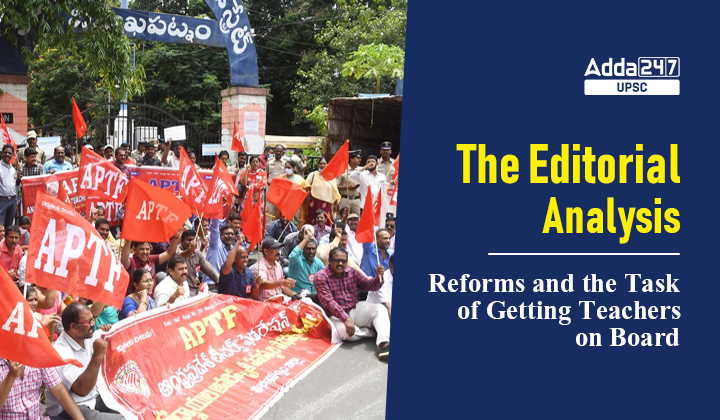Table of Contents
Reforms in Education Sector- Relevance for UPSC Exam
- GS Paper 2: Governance, Administration and Challenges
- Government policies and interventions for development in various sectors and issues arising out of their design and implementation.
Reforms in Education Sector by Andhra Pradesh in News
- Recently, the Y.S. Jagan Mohan Reddy government in Andhra Pradesh has taken many reforms in the education sector.
India- UAE MoU on Cooperation in the Field of Education
Reforms in Education Sector
- Mission: Educational Reforms are aimed to ensure that all children have access to quality education within an equitable and inclusive classroom environment.
- These reforms will take into account diverse backgrounds and different academic abilities of each students, thereby making them active participants in the learning process.
- Objective: The objective is to shift the focus from content retention to building critical thinking and problem-solving abilities, making the learning process more experiential, holistic, integrated, enquiry-driven, and enjoyable.
- To this, the government is redefining the tasks, the training patterns and the professional development mode of teachers.
- School Restructuring Programme: it calls for a merger of classes three to five in primary schools with high schools.
- App Based Attendance System: The new app-based attendance system is a pilot project that was rolled out by the government in August in State-run schools.
- Teachers presence is needed during their attendance, as the Unified District Information System for Education (U-DISE)-linked system records metrics such as the longitude and latitude of the place where they are present.
- Attendance is sent to officials by SMS.
- Parents will also receive SMS updates on their child’s arrival and departure from school.
Reforms in Education Sector- Concerns of Teacher Unions
- Teacher unions are sceptical about the results of these reforms, which are being aligned with the National Education Policy (NEP) 2020.
- School Restructuring Programme: The believe it will further contribute to the school drop-out rate as it will deprive a large population of students who live in remote rural and tribal pockets of education.
- Increased Workload: They also say that the government order 117 on reapportionment of teaching staff in the State will only increase their workload in addition to shrinking existing teacher posts.
- Concerns with Facial Recognition App: The introduction of a face recognition app by the School Education Department, asking teachers to download it in on their personal mobile phones and record their daily attendance, has further angered teachers.
- Citing virtual security reasons, teacher unions are refusing to follow the instructions and have urged teachers across the State to boycott use of the app.
- They have demanded that the government provide them devices, as in the past, when they recorded their attendance using an Aadhar-enabled biometric attendance system.
Way forward
- Rectifying the Errors: The Minister has promised to address other issues such as poor or no Internet connectivity in villages and tribal habitations.
- Technology-driven approach: Education Department officials say that such technology-driven effective mechanisms are needed to check teacher absenteeism.
- We need a fool-proof system in place to ensure transparency and accountability.
Conclusion
- While the State has embarked on radical changes in the curriculum, school-restructuring and the mode of teaching, teacher unions remain nonchalant.
- It is expected that they should now step out of their traditional role of teaching academic content in a classroom and, instead, focus on acquiring new abilities, skills and showing greater commitment.
Online Education in India: Benefits, Issues and Government Steps
Online Education in India: Benefits, Issues and Government Steps




 TSPSC Group 1 Question Paper 2024, Downl...
TSPSC Group 1 Question Paper 2024, Downl...
 TSPSC Group 1 Answer key 2024 Out, Downl...
TSPSC Group 1 Answer key 2024 Out, Downl...
 UPSC Prelims 2024 Question Paper, Downlo...
UPSC Prelims 2024 Question Paper, Downlo...
